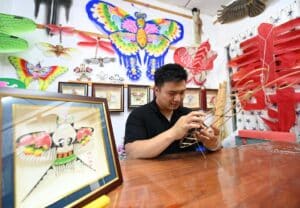Cyprus Mail 5 September 2023 - by Paul Lambis
 |
| Nicholas Ladommatos |
In artisans continuing the traditional crafts of their forebears PAUL LAMBIS finds a range of products linking the presence to the past
China and Cyprus may be worlds apart but they have rich legacies that have left behind innumerable literary classics, historical records and cultural relics. The two countries’ intangible cultural legacy is linked to traditional forms of craftsmanship, which tell stories from the past, frequently symbolising the progression of existence and the importance of rituals and traditions.
These crafts, which include clothing, jewellery, theatrical and festival props, decorative art, ritual objects, musical instruments, household utensils and a plethora of other objects used for both educational and entertainment purposes, have become heirlooms that are passed down from generation to generation.
China has increased its efforts over the past few years to preserve and improve old practices, as well as to strengthen cultural protection. In fact, the Chinese ministry of commerce has recognised over 1,000 time-honoured processes, or ‘laozihao’ as they are referred to in Chinese.
The Yangliuqing woodblock painting was once one of the most popular forms of New Year decorations in China, flourishing in Tianjin and the surrounding areas between the late Ming (1368-1644) and the early Qing (1644-1911) dynasties.
Huo Shulin is the seventh generation in his family of the Yangliuqing New Year painting skill. When he was ten years old, he began learning the skill from his father, Huo Qingyou, respected for his art on a national level. He has gathered old paintings over the years and established a museum of Yangliuqing New Year Paintings. Nowadays, Huo Shulin and his wife Wang Dan combine elements from Yangliuqing New Year Paintings with modern culture to create items that appeal to younger audiences.

Yiorgos Tsangaris
Similarly, Yiorgos Tsangaris acquired the age-old tradition of printmaking from his father, renowned printmaker Hambis Tsangaris, who founded the first printmaking school in 1995 with the aim of showcasing multiple printmaking techniques and methods by international and local artists from the 16th century to the present.
Today, Yiorgos Tsangaris is the art director of the Hambis Printmaking Municipal Museum in Nicosia, which provides visitors with an understanding of the art’s historical course, techniques and materials through the rich collection on display, which includes old books, maps, printmaking equipment and engraved plates with prints.
Kite-making has also been a traditional Chinese folk craft in northern China. In 2008, Tianjin Kite Wei was designated as a national intangible cultural heritage.

Wei Bowen is Kite Wei’s sixth-generation inheritor. He returned to his hometown after graduating from university to produce kites with his father, Wei Guoqiu. In recent years, he has incorporated fashion themes into his kite designs. Wei Bowen returned to his university to promote kite-making skills in an effort to pass it on to the next generation.
While Cypriot artist Nicholas Ladommatos is not dedicated to kites, he does employ geometric art to create a visual sensory experience. Incorporating lines, squares, triangles, circles and combinations of the above, this contemporary artist, whose artistic inspiration came from his father, looks at each piece in his collection as a construction process. Ladommatos’ concepts are translated onto canvas, plexiglass, wood, or metal, and utilising acrylics, synthetic materials and sand paste, bring life to his colourful compositions with a special emphasis on Cyprus and the Mediterranean.
On the culinary front, Mahua, or fried dough twist, is made in a variety of ways in China with traditional flavour ranging from sweet to spicy. Mahua has been around for thousands of years, however it is now regarded a Tianjin signature dish.
 |
| Wang Hongde instructs his apprentice Zhao Baoyang in making fried dough twists in north China’s Tianjin |
Wg Hongde is the production workshop director of Tianjin Guifaxiang 18th Street Mahua. The craft was officially recognised as a national intangible cultural heritage in 2014. After graduating high school, Wang studied the art of making Mahua with elderly masters in the 1980s. Today, Wang Hongde has mastered the culinary art and even produced a giant Mahua weighing 50kg.
The Cyprus Delight, or loukoumi, is a confection made from starch and sugar that has been an all-time favourite delicacy on the island since the 19th century, and for one family from Geroskipou, Paphos it has been a family staple for four generations. Since 1994, George Gabriel has been at the helm of his great-grandfather’s business, which has expanded to include a new purpose-built factory in Geroskipou, where production continues to this day. In 2004, George’s company, Aphrodite Delights, was awarded the Guinness World Record for the largest loukoumi, weighing 2,532kg.
The significance of these traditional forms of art should not be underestimated; they are an important component of our cultural identity, transcending political and linguistic boundaries. They are a form of communication, often bringing people from different walks of life and cultures together without saying a word.
Mirror of Culture
Mirror of Culture is a joint initiative of the Cyprus Mail and the Embassy of China in Cyprus. It highlights the parallels between Cypriot and Chinese culture to set an example of acceptance, respect and understanding among the various cultural communities in Cyprus, at the same time recognising the fundamental importance of culture.
Culture is the universal language of mankind that transcends many barriers, including language and geography. Our aim is to work with diverse cultural communities in Cyprus to share and promote our vibrant cultures to further bolster the bonds among all the people of Cyprus and celebrate the diversity of cultures in the world.
Furthermore, the initiative understands the importance of cultural preservation, which is an important way for us to transmit traditions and practices of the past to future generations.